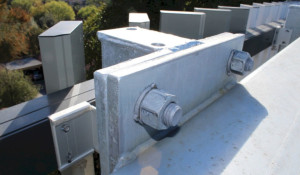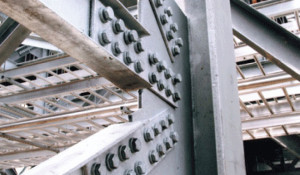In 1837, Stanislaus Sorel received a patent for galvanizing. Even though the process has been around for over 175 years, it’s not your great, great, great grandfather’s galvanizing!
Of course, many of the same principles still apply…outstanding corrosion protection, metallurgical bonding,100% surface protection of the interior and exterior of steel fabrications… but the galvanizing industry has adapted to the demands of the 21st century by recognizing that there is more to it than stopping rust. This article will highlight some of the technical and marketing trends benefitting the engineering community.
On the technical side, there are several issues currently being addressed by the industry, with the charge being lead by the American Galvanizers Association. Of particular note and impact on the engineering community are Slip Factors for Slip Critical Connections and Hydrogen Embrittlement/Galvanizing A-490 Bolts.

A slip factor study by the American Galvanizers Association is in the final stages of research. The goal of the study is a guideline or specification with instructions on preparing a galvanized surface to achieve a Class B slip coefficient. With a higher slip coefficient, designers will be able to use galvanized steel in applications previously not considered or decrease costs by using less connections. Previous phases of testing indicate that obtaining the required 0.50 slip coefficient through roughening or other treatments is not possible. Therefore, the testing is focused on the use of a zinc-rich paint over the galvanized surface to obtain the Class B slip coefficient. The final phase of testing is slated to occur in 2015.
Another study deals with the feasibility of hot-dip galvanizing A490 bolts without a danger of hydrogen embrittlement. Hydrogen embrittlement originates in the cleaning step of the hot-dip galvanizing process. During the process, the heating of the steel causes some of the atomic hydrogen absorbed from the pickling acid to migrate into “trap sites” within the steel matrix. Once in the trap site, the hydrogen atoms can cause a premature failure of the steel fastener when installed in the field. Removing the source of hydrogen atoms (pickling acids) from the galvanizing process essentially eliminates the concern for hydrogen embrittlement failure. To accomplish this, the time the steel spends immersed in the pickling acids must be eliminated, as this is the only source of hydrogen atoms in the process. Mechanical surface preparation (blasting or wheel abrading) of the steel after the degreasing stage will solve the problem. The study tested several bolts galvanized with this modified process for compliance with ASTM and other standards. Results of these tests were typical for hot-dip galvanizing, showed no adverse effect on the coating from the modified process, and met the requirements of ASTM A153. The A490 bolt study has been completed and is being introduced to ASTM for inclusion in the specification. There may be further testing to explore other steel base materials to prove there is no difference in their hydrogen threshold after galvanizing. More tests will be done in 2015, and the total report will be published with a change proposed to the new specification on high strength bolts. It should be noted that these practices have been utilized in Europe for many years, and the use of hot-dip galvanized A490 bolts is an accepted practice in design and construction.
In addition to addressing technical issues, the galvanizing industry has come to realize that there are other initiatives that can benefit both the galvanizer and engineer. These areas fall into three basic categories: Education, Sustainability, and Marketing Opportunities.
Educating the next generation of architects and engineers is a priority. Many have little or no knowledge of the galvanizing process. Their college curriculum skims over (or ignores) the need for corrosion protection. Visits to college campuses and A/E/C offices across the United States and Canada are being held to educate future architects and engineers about hot-dip galvanized steel. Through these presentations, students and “emerging professionals” will learn about the galvanizing process, design, sustainability, performance, specification, cost, and inspection.

Hot dip galvanizing is universally recognized as environmentally friendly. In reference to LEED® category Materials and Resources – Credit 4.1 and 4.2 Recycled Content, the steel and zinc used in the hot dip galvanizing process contain 56.1% post-consumer recycled content and 31.17% pre-consumer recycled content. Recently, the U.S. Green Building Council approved the new LEED v4 rating system, which revamped the Materials & Resources credit area. The change targets more transparency in materials to assist in selecting more sustainable building products. The requirements have been changed to more objective measures – Environmental Product Declarations (EPDs) which are based on life-cycle assessment (LCA) data. This more objective and transparent measurement of sustainability favors hot-dip galvanized steel because of its durability, low life-cycle cost, and 100% recyclability – unmatched by most competitive systems.
The old marketing adage “grow or die” also pertains to the galvanizing industry. The galvanizing process can no longer remain an afterthought. Through the efforts of the American Galvanizers Association as well as some individual galvanizers, great strides have been made to advance the use and knowledge of hot dip galvanizing. By reaching out, the galvanizing industry has seen trending growth in zoos, short span bridges, and parking structures to name a few market segments. By utilizing empirical data to prove long-term effectiveness, there has been increased growth in the use of duplex coatings (both liquid and powder) in the bridge & highway and structural markets.▪
